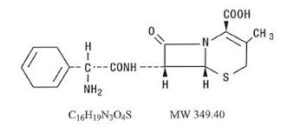VELOSEF (Cephradine)
ویلوسیف
Lower respiratory diseases intense and constant bronchitis, lobar and bronchopneumonia,
Also cystitis, urethritis, pyelonephritis Skin and soft tissue infections: abscess, cellulitis, furunculosis, impetigo. Cephradine, parenteral formulations.
Clean Cephradine for infusion is shown basically for thoss patients unfit to endure oral medicine. It is additionally shown for intravenous utilize either by direct infusion or by intravenous imbuement for the treatment of serious and dangerous diseases.
 Dosage and Administration:
Dosage and Administration:
As with antibiotic treatment in general, therapy should be continued for a minimum of 48 to 72 hours after the patient becomes asymptomatic or evidence of bacterial eradication has been gotten, in Diseases brought about by bunch A beta-hemolytic streptococci, at least 10 days of treatment is prescribed to make preparations for the gamble of rheumatic fever or glomerulonephritis. In the therapy of ongoing urinary lot diseases. incessant bacteriologic and clinical examination is important during treatment and might be vital for a long time subsequently. Determined contaminations might require treatment for quite some time.
Cephradine, oral formulations: For oral use. Cephradine, parenteral formulations: For Intramuscular use & For intravenous use.
 Adults:
Adults:
Cephradine, oral formulations: Respiratory tract infections and skin and soft tissue infections: The usual dose is 250 mg or 500 mg every 6 hours or 500 mg or 1 g every 12 hours depending on the severity and site of infection. Uncomplicated urinary tract infections: The usual dose is 500 mg every 6 hours or 1 g every 12 hours. Cephradine, parenteral formulations: The usual daily dose is 2 to 4 g daily in four equally divided doses intramuscularly or intravenously. A dosage of 500 mg four times a day is adequate in uncomplicated pneumonia, skin and skin structure infections, and most urinary tract infections. maximum dose should not exceed 8 g per day .Prophylaxis: to forestall postoperative disease in debased or possibly tainted a medical procedure, suggested portions are as per the following:
- 1 g each 4 to 6 hours after the primary portion for one to two dosages or for as long as 24 hours postoperatively.
Prophylaxis in cesarean section:
The first dose of 1 g is administered intravenously as soon as the umbilical cord is clamped.The second and third doses should be given as 1 g intravenously or intramuscularly at 6 and 12 hours after
the first dose.
The most extreme portion shouldn’t surpass 4 g each day. Dosages for kids shouldn’t surpass portions suggested for grown-ups. 1 g each 4 to 6 hours aThe second and third dosages ought to be given as 1 g intravenously or intramuscularly at 6 and 12 hours afterfter the primary portion for one to two portions or for as long as 24 hours postoperatively.
 Contraindications:
Contraindications:
Chadren may require dosage modification proportional to their weight and severity of infection.
component of the formulation.
A changed measurement plan for patients with diminished renal capability is vital. Misleading positive response for glucosa: Change treatment with Cephradine, a bogus positive response for glucose in the pee might happen with Benedict’s or alternately Fehling’s answer or with reagent tablets like Clinitest, yet not with chemical based tests like Clinistix or Diastas. Delayed use: Likewise with all anti-microbials, delayed use might bring about abundance of non-helpless creatures. Excessive touchiness peculiarities: Extreme touchiness peculiarities are bound to happen in people who have extreme touchiness and those with a background marked by sensitivity, asthma, roughage fever or urticaria. History of involved with alert in those patients with a known history colitis/gastrointestinal of colitis/gastrointestinal
Cephradine should disorders.
Excipients
Cefradine, 125 mg/5 ml, powder for oral suspension
Sunset Yellow FCF (E110; FD&C Yellow 6)
Contains Dusk Yellow FCF, which might cause unfavorably susceptible sort responses.
Cefradine, 250 mg/5ml, powder for oral suspension
FD&C Red 40
Contains FD&C Red 40 which may cause allergic-type reactions.
Penicillins, loop diuretics, probenecid, oral contraceptives, Warfarin, Live typhoid vaccine.
Adverse Reactions:
Infections and infestations, Blood and lymphatic system disorders, Immune system disorders, Psychiatric disorders, Nervous system disorders, Gastrointestinal disorders, Hepatobiliary disorders, Renal and urinary disorders, Skin and subcutaneous tissue disorders, Musculoskeletal and connective tissue disorders, General disorders and administration site conditions, Vascular disorders.
Overdosage:
upsets
Version No: NCDS 05
Version Date: 13 February 2020
خوراک اور طریقہ استعمال:
ڈاکٹر کی ہدایت کے مطابق استعمال کریں۔ تمام ادویات بچوں کی پہنچ سے دور رکھیں۔
انجکشن: دوا کو کمرے کے درجہ حرارت (300-150) میں رکھیں ۔ گرمی کی شدت اور روشنی سے بچائیں۔ سپنشن: پاؤڈر کی حالت میں دوا کو کمرے کے درجہ حرارت (300-150) میں رکھیں ۔ تیار شده سپنشن اگر کمرے کے درجہ حرارت 3000-150) میں رکھا گیا ہو تو 7 دن تک اور ریفریجریٹر (800-20 ) میں رکھا گیا ہو تو 14 دن تک استعمال کیا جا سکتا ہے۔
صرف پینے کے لئے استعمال کریں۔ کپسول: دوا کو کمرے کے درجہ حرارت (300-150) میں رکھیں۔ صرف کھانے کے لئے استعمال کریں ۔
